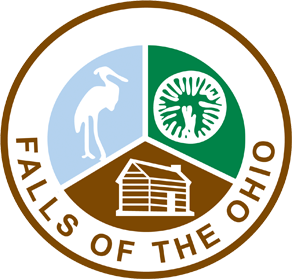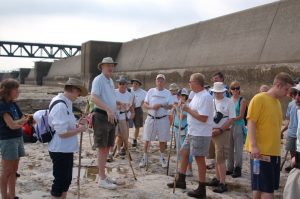Our Naturalist at Heart program seeks to develop learners and leaders for our community.
We are always seeking new volunteers!
Contact Alan Goldstein at (812) 590-8429 or agoldstein@dnr.in.gov for details.
Do you want to be able to answer questions that your children, grandchildren or friends have about geology, river ecology and natural & cultural history ? Yes? We are providing the opportunity for you to become a knowledgeable and inspired volunteer in our community. Consider joining our Naturalist at Heart program! All we ask from you is some time and energy.
To enter the Naturalist at Heart program, you must participate in a short interview with our Volunteer Coordinator, then complete our application form .There are many opportunities to get involved with the program at a pace determined by you.
What is Interpretation?
“Interpretation” is defined as the activities through which a museum carries out its mission and educational role: Interpretive media/activities include, but are not limited to: exhibits, tours, websites, classes, school programs, publications, outreach.
The Naturalist at Heart program operates on three simple premises:
1. Process — We learn best by doing, by being actively engaged, hence the program emphasizes service as an effective learning strategy. In the context of this program, service means sharing what you learn with Falls of the Ohio visitors.
2. Content — We “will not fight to save what we do not love,” and we tend to love that which we understand. Therefore, the program emphasizes learning about our region’s geologic history and native flora and fauna.
3. Reflection — An intimate knowledge of the local landscape and the natural cycles that sustain humans and other life forms can be a springboard into greater global ecological understanding.
Our Naturalist at Heart program seeks to develop learners and leaders for our community.
What do you get out of it?
- Once enrolled into the program, participants get free admission to “Falls Fundamentals” programs – a series of diverse, in-depth workshops.
- Opportunities to continually develop and sharpen skills as an interpretive naturalist and to move into different training levels at your own pace.
- A supportive learning environment consisting of park staff, experts in a variety of fields and volunteers.
- Opportunities to experience more fully the rich natural and cultural heritage of the region, through classes, field trips, etc.
- Opportunities to use new knowledge and skills to help others learn about natural and cultural history, ecology, geology, and how these disciplines are intertwined.
What’s in it for the Falls of the Ohio State Park?
Research has shown that most people who care about nature have been influenced by others who are enthusiastic and show respect for their natural heritage. With over a half million visitors to the Falls of the Ohio annually, the staff can only reach a fraction of those who wish to learn. Through the Naturalist at Heart program, we are able to offer an enriching experience to more visitors.
Volunteers are expected to contribute to the Falls’ mission of providing opportunities for education and recreation while protecting the resources. As a volunteer in the Naturalist at Heart program, you will:
- Bring fresh ideas and enthusiasm.
- Through stationary and roving activities on the grounds, help more visitors make meaningful connections through informal interpretive opportunities.
- Become knowledgeable about specific program areas such as the geology of the park, George Rogers Clark, birds at the Falls, etc. and to offer or assist with related programs.
- Work with school and scout groups throughout the year.
- Extend the Falls’ capacity for offering a variety of program options such as morning and evening hikes, bird watching, nature exploration at the Button Bush wetland area or a hands-on fossil station by the gazebo.
- Be off-site representatives for our programs in your community.
- Spread the wealth of knowledge throughout the community and region.
- Mentor other volunteers.
- Become more literate about the natural world through reading books and articles.
- Assist or lead in hands-on projects, such trail development, garden interpretation and maintenance, cleaning selected areas of the fossil beds, and more.

